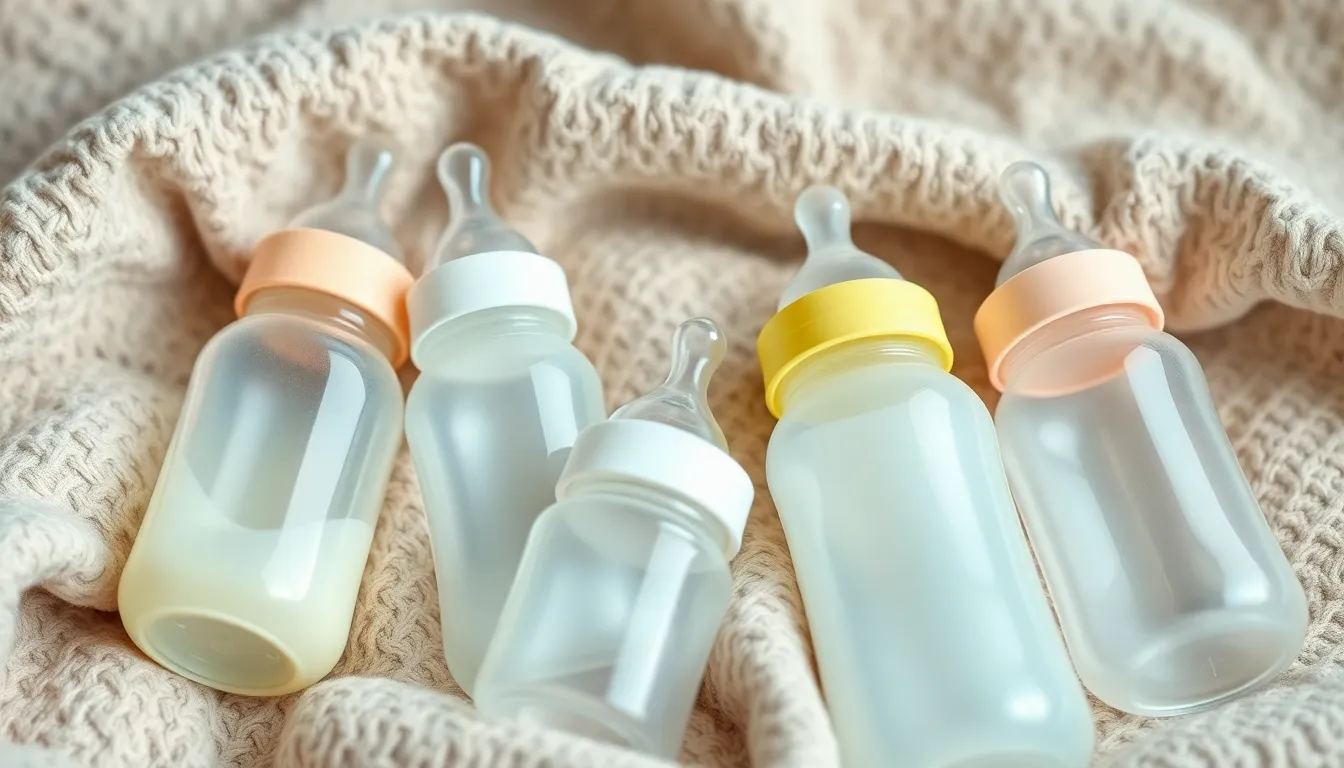Choosing the right baby bottle for a newborn can feel like picking the perfect avocado—overwhelming and full of pressure. After all, the last thing any parent wants is a fussy baby who’s more interested in the bottle than the milk. With a dizzying array of options out there, it’s easy to get lost in the sea of colorful designs, fancy features, and endless claims of “the best.”
Table of Contents
ToggleTypes Of Baby Bottles For Newborns
Selecting the right baby bottle for a newborn involves understanding the different types available. Each type has unique features that cater to various needs.
Plastic Bottles
Plastic bottles remain a popular choice due to their lightweight nature. Many parents appreciate that they are virtually unbreakable, making them safe for use around infants. Additionally, various shapes and sizes help parents find the ideal bottle for their baby’s feeding habits. BPA-free options ensure safety, keeping harmful chemicals away from the baby. Cleaning plastic bottles is typically hassle-free, often allowing for dishwasher use.
Glass Bottles
Glass bottles offer a classic option for parents looking for durability and safety. These bottles are free from harmful chemicals and don’t retain odors or stains, promoting a clean drinking experience. Their heavier weight can provide a sense of stability during feeding sessions. Many brands design glass bottles with protective sleeves to prevent breakage and enhance grip. Parents often notice that glass bottles maintain temperature longer than their plastic counterparts, providing a comfortable feeding experience.
Silicone Bottles
Silicone bottles introduce flexibility and safety, making them an appealing choice for many parents. These bottles can withstand temperature changes, making them suitable for both hot and cold liquids. Their soft material encourages a comfortable grip for parents during feeding times. Silicone bottles are often collapsible, providing convenient storage. Various designs also allow for easy cleaning, often being dishwasher safe.
Features To Consider

Selecting the right baby bottle involves understanding key features that positively impact feeding experiences. Consider the following aspects to ensure the bottle meets both baby and parent needs.
Nipple Shape And Flow
Nipple shape affects the baby’s latch and sucking comfort. Wide-neck nipples mimic the mother’s breast, while traditional shapes may suit different preferences. Flow rate plays a crucial role in the feeding process too. Bottles with multiple flow options offer adaptability as babies grow and their feeding skills develop.
Bottle Material
Material impacts both safety and functionality. Plastic bottles are lightweight and unbreakable, making them practical for daily use. BPA-free alternatives ensure a safer choice for newborns. Glass bottles provide durability and an odor-free experience, while silicone options are flexible and gentle in temperature. Each material type has distinct advantages that cater to parental preferences.
Size And Capacity
Bottle size and capacity vary significantly among options. Smaller bottles work well for newborns who consume less at each feeding, often around 2 to 4 ounces per feeding. Larger bottles, typically holding 8 to 9 ounces, accommodate growing appetites. Considering how much a baby typically eats can guide parents in choosing the right size to avoid constant refills.
Popular Brands
Several brands stand out when selecting baby bottles for newborns. Each offers unique features catering to parents’ needs.
Brand A
Brand A focuses on innovative designs that promote easier latching. Their bottles feature wide-neck nipples that closely resemble the mother’s breast, making feeding a more natural experience. Parents appreciate the soft silicone material that is gentle against baby’s skin. Additionally, many of their bottles are made from BPA-free plastic, ensuring safety during use. Parents report high satisfaction levels with these bottles, often noting reduced colic symptoms in their infants.
Brand B
Brand B emphasizes durability and comfort in its products. Their glass bottles offer a clean drinking experience without retaining smells or flavors, appealing to parents concerned about hygiene. Design elements, such as ergonomic grips, make handling easier for caregivers. They also include a variety of nipple flow rates, allowing customization based on the baby’s preferences and feeding style. Many users commend this brand for its commitment to quality and safety.
Brand C
Brand C specializes in multifunctional feeding solutions. Their silicone bottles are flexible, with heat resistance that helps prevent cracking. Designed for easy gripping, these bottles provide comfort during feeding. A notable feature is their ability to be easily cleaned, as they are dishwasher safe. Parents often highlight the convenience of using these bottles, particularly for on-the-go feeding. The emphasis on safety through durable, non-toxic materials makes this brand a popular choice among parents.
Cleaning And Maintenance Tips
Maintaining baby bottles is crucial for ensuring a safe feeding experience. Clean bottles regularly to prevent bacteria growth and ensure the baby’s health.
Sterilization Methods
Boiling water serves as a simple method for sterilizing baby bottles. Placing clean bottles in boiling water for five to ten minutes effectively eliminates harmful germs. Steam sterilizers provide another reliable option, using steam heat to disinfect bottles quickly and thoroughly. For convenience, some parents opt for microwave sterilizers, which achieve sterilization within minutes. Chemical sterilization with sterilizing tablets also works as a practical alternative. Following the manufacturer’s instructions ensures optimal results for each method.
Proper Storage
Storing baby bottles correctly protects their cleanliness and integrity. Keeping bottles in a designated, clean area prevents contamination from dust and other particles. Use storage containers that allow bottles to air dry completely before sealing. Placing bottles upright avoids deformation and potential damage, particularly with silicone and plastic materials. Regularly checking for any signs of wear or damage also maintains safety. Discard any bottles showing cracks or discoloration to ensure the baby’s safety.
Choosing the right baby bottle for a newborn is a significant decision for parents. With various materials shapes and features available it’s essential to select a bottle that suits both the baby’s needs and the parents’ lifestyle. Each option from plastic to glass and silicone offers unique benefits that can enhance the feeding experience.
By considering factors like nipple shape flow rate and bottle size parents can navigate the overwhelming choices more confidently. Keeping bottles clean and well-maintained ensures a safe feeding environment. Ultimately the right baby bottle can make a positive difference in a newborn’s feeding routine and contribute to their overall comfort and satisfaction.



